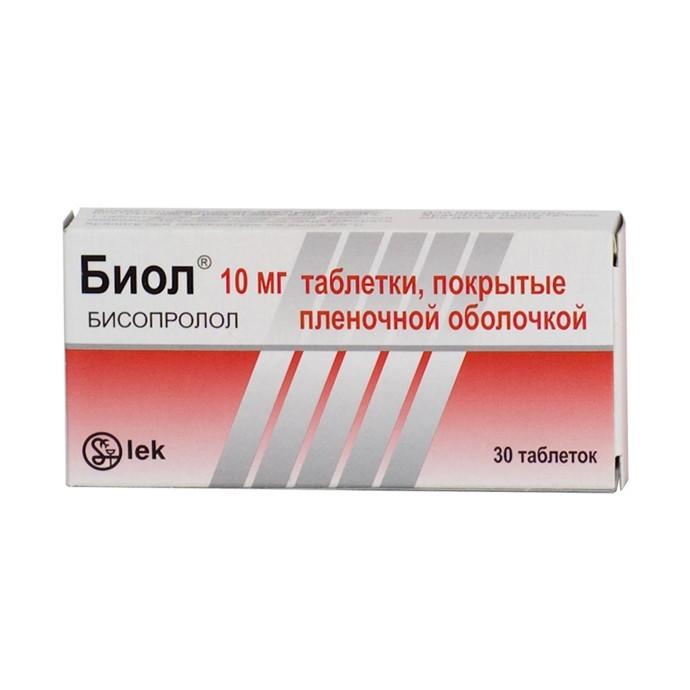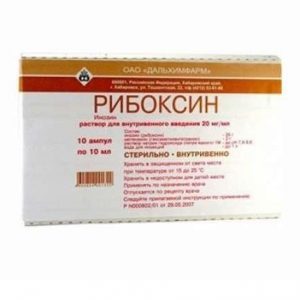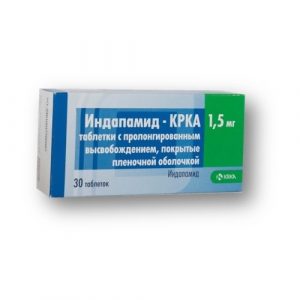Description
Release form
Film-coated tablets.
Packing
30 pcs. There are 10 tablets in a blister. In a cardboard box 3 blisters.
Pharmacological action
Biol – selective beta1-blocker without its own sympathomimetic activity. It does not have a membrane stabilizing effect. Reduces the activity of renin in blood plasma, reduces the need for myocardium in oxygen, reduces heart rate at rest and during exercise. It has hypotensive, antiarrhythmic and antianginal effects. Blocking in low doses the 1-adrenergic receptors of the heart, it reduces the formation of cAMP stimulated by catecholamines from ATP, reduces the intracellular current of calcium ions, and has a negative chrono-, dromo-, batmo- and inotropic effect. It inhibits conduction and excitability, slows AV-conduction. OPSS in the first 24 hours of drug use increases (as a result of a reciprocal increase in the activity of -Adrenoreceptors and the elimination of stimulation of 2-adrenergic receptors), which after 1-3 days returns to the original, and with prolonged administration decreases.
The antihypertensive effect is associated with a decrease in minute blood volume, sympathetic stimulation of peripheral vessels, a decrease in the activity of the renin-angiotensin system (more important for patients with initial hypersecretion of the renin), restoration of the sensitivity of the aortic arch baroreceptors (there is no increase in their activity in response to a decrease in blood pressure and effect on the central nervous system). With arterial hypertension, the effect occurs after 2-5 days, a stable hypotensive effect after 1-2 months.
The antianginal effect is due to a decrease in myocardial oxygen demand as a result of decreased heart rate and reduced contractility, lengthening of diastole, and improved myocardial perfusion. By increasing the final diastolic pressure in the left ventricle and increasing the stretching of the muscle fibers of the ventricles, it can increase the need for oxygen, especially in patients with chronic heart failure.
Antiarrhythmic effect is due to the elimination of arrhythmogenic factors (tachycardia, increased activity of the sympathetic nervous system, increased content of cAMP, arterial hypertension), a decrease in the rate of spontaneous excitation of sinus and ectopic pacemakers, and a slowdown in AV conduction (mainly in antegrade and, to a lesser extent, in retrograde directions through the AV node) and along additional paths.
When used in medium therapeutic doses, unlike non-selective beta-blockers, has a less pronounced effect on organs, containing 2-adrenergic receptors (pancreas, skeletal muscle, smooth muscles of peripheral arteries, bronchi and uterus) and for carbohydrate metabolism. Does not cause sodium ion retention in the body. With an increase in the dose above the therapeutic, it has a beta2-blocking effect.
Contraindications
severe arterial hypotension (systolic blood pressure less than 90 mm Hg, especially with myocardial infarction)
acute heart failure, chronic heart failure at the stage of decompensation
cardiogenic shock collapse, pulmonary edema
AV block II and III degree (without installing a pacemaker)
sinoatrial blockade
sinus syndrome weakness
severe sinus bradycardia sdk / min heart rate less than 50 min. peripheral circulatory disorders, Raynaud’s disease
concomitant use of MAO inhibitors (except for MAO type B)
metabolic acidosis
severe forms of bronchial asthma and chronic obstructive disease l soft (in history)
age of 18 years (effectiveness and safety have not been established)
pregnancy and lactation
hypersensitivity to bisoprolol and other components of the drug to other beta-blockers.
Caution: severe hepatic insufficiency
severe renal failure
thyrotoxicosis
psoriasis
myasthenia gravis
AV blockade I degree
angina pectoris primalmetal
depression common history of diabetes mellitus surgical intervention
severe allergic reaction (history).
Special instructions
Do not abruptly interrupt Biol treatment because of the risk of severe arrhythmias and myocardial infarction. Cancellation is carried out gradually, reducing the dose by 25% every 3-4 days.
Monitoring of patients taking Biol should include measurement of heart rate and blood pressure (at the beginning of treatment – daily, then 1 time every 3-4 months), ECG, determination of glucose level in patients with diabetes mellitus.
Composition
In 1 film-coated tablet contains:
Active ingredient: bisoprolol hemifumarate 10 mg.
Excipients:
Microcrystalline cellulose, calcium hydrogen phosphate, corn starch, croscarmellose sodium, magnesium stearate, anhydrous colloidal silicon dioxide.
Composition of the film coat:
Lactose monohydrate, hypromellose, titanium dioxide, macrogol-4000, dye iron (III) oxide yellow.
Dosage and administration of
Tablets should be taken in the morning, regardless of food intake, do not chew, drink a small amount of
liquid. In all cases of arterial hypertension and angina pectoris, the doctor sets the dosing regimen individually, given heart rate and the condition of the patient. The initial daily dose is 5 mg (sometimes 2.5 mg) 1 time per day, if necessary, increase the dose to 10 mg 1 time per day. The maximum daily dose is 20 mg.
In patients with severe renal failure (CC less than 20 ml / min) or with severe impaired liver function, the maximum daily dose should not exceed 10 mg.
Dose adjustments for elderly patients are usually not required, however, for some patients, a dose of 5 mg per day may be optimal.
Side effects
From the central nervous system: fatigue, weakness, asthenia, dizziness, headache, sleep disturbances, nightmares, mental disorders (depression), paresthesia in the limbs (in patients with intermittent claudication and Raynaud’s syndrome), impaired concentration, myasthenia gravis, tremor.
On the part of the organ of vision: visual impairment, decreased secretion of lacrimal fluid (should be taken into account when wearing contact lenses), dry and sore eyes, conjunctivitis.
From the cardiovascular system: orthostatic hypotension, pain in the sternum, sinus bradycardia, impaired myocardial conduction, AV block, withdrawal syndrome (increased angina attacks, increased blood pressure), manifestation of angiospasm (increased peripheral circulation disorders, coldness of the lower extremities, syndrome Raynaud) development (aggravation) of the course of chronic heart failure.
From the digestive system: dry oral mucosa, nausea, vomiting, dyspepsia, diarrhea, taste change, liver dysfunction (symptoms of cholestasis), hepatitis, increased levels of ALT, AST, bilirubin.
From the respiratory system: nasal congestion, pharyngitis, rhinitis, sinusitis, cough, in predisposed patients – laryngo- and bronchospasm.
From the skin: increased sweating, flushing of the skin, exanthema, psoriasis-like skin reactions, exacerbation of the symptoms of psoriasis, alopecia.
From the hemopoietic system: thrombocytopenia, agranulocytosis, leukopenia.
Allergic reactions: pruritus, rash, urticaria.
Other: increased sweating, back pain, arthralgia, muscle pain, violation of sexual function, dysuria, hyperglycemia (in patients with non-insulin-dependent diabetes mellitus), hypoglycemia (in patients receiving insulin), hypothyroid state, increased triglycerides.
Drug Interactions
Allergens, used for immunotherapy (or allergen extracts for skin tests) increase the risk of severe systemic allergic reactions and anaphylaxis in patients receiving bisoprolol.
Cardiac glycosides, methyldopa, reserpine and guanfacine, slow calcium channel blockers (verapamil, diltiazem), amiodarone and other antiarrhythmic drugs increase the risk of developing or worsening bradycardia, AV block, heart failure and heart failure.
Diuretics, clonidine, sympatholytics, hydralazine, nifedipine and other antihypertensive drugs can lead to an excessive decrease in blood pressure.
Iodine-containing radiopaque agents for iv administration increase the risk of anaphylactic reactions.
Phenytoin with iv administration, drugs for inhalation general anesthesia (hydrocarbon derivatives) increase the severity of cardiodepressive action and the likelihood of lowering blood pressure.
Bisoprolol masks the adrenergic symptoms of thyrotoxicosis and hypoglycemia (e.g., tachycardia).
Reduces clearance of lidocaine and xanthines (except diphillin) and increases their concentration in blood plasma, especially in patients with initially increased clearance of theophylline under the influence of smoking.
The antihypertensive effect of bisoprolol is weakened by NSAIDs (sodium ion retention and prostaglandin synthesis blockade by the kidneys), GCS and estrogens (sodium ion retention).
Extends the effect of non-depolarizing muscle relaxants and the anticoagulant effect of coumarins.
Tri- and tetracyclic antidepressants, antipsychotics (antipsychotics), ethanol, sedatives and hypnotics increase central nervous system depression.
The simultaneous use with MAO inhibitors is not recommended due to a significant increase in the antihypertensive effect, the break in treatment between taking MAO inhibitors and bisoprolol should be at least 14 days.
Non-hydrogenated ergot alkaloids increase the risk of peripheral circulation disorders.
Sulfasalazine increases the concentration of bisoprolol in blood plasma.
Rifampicin shortens T 1/2 of bisoprolol.
Overdose
Symptoms: arrhythmia, ventricular extrasystole, severe bradycardia, AV block, marked decrease in blood pressure, acute heart failure, hypoglycemia, acrocyanosis, shortness of breath, bronchospasm, dizziness, fainting, court.
Treatment: gastric lavage and administration of absorbent drugs. Symptomatic therapy is carried out: with developed AV-blockade – iv administration of atropine (1-2 mg), epinephrine or staging a temporary pacemaker with ventricular extrasystole – lidocaine (IA class drugs are not used) with a decrease in blood pressure – the patient should be in the Trendelenburg position if there are no signs of pulmonary edema – iv plasma-replacing solutions, with inefficiency – the introduction of epinephrine, dopamine, dobutamine (for maintenance of chronotropic and inotropic effects) in heart failure – cardiac glycosides, diuretics, glucagon for seizures – iv diazepam for bronchospasm – beta 2 -adrenergic agonists but.
Storage Conditions
Keep out of the reach and sight of children at temperatures not exceeding 25 ° C.
Expiration
4 years.
Active substance About
bisoprolol
prescription471540
Prescription
lekarstvennaja form
tablets
Prescribing
For adults as prescribed by a doctor
Indications
Indications
Hypertension, Heart failure, Arit Mia




